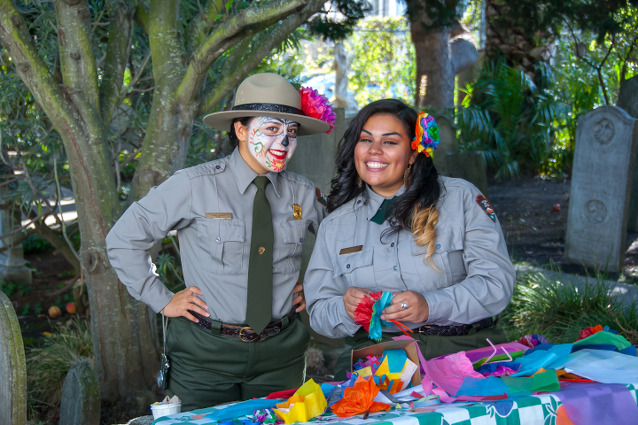The histories of Latino and Latinas in America are diverse. They include the experiences of people with cultural, religious, and linguistic traditions from Spain, Mexico, Cuba, Puerto Rico, Dominican Republic, Guatemala, El Salvador, Costa Rica, and Nicaragua, among other nations from Latin America and Iberia. It is impossible to tell the experiences of these various groups with a single history.
The breadth of Latino/a experience is a vital aspect of America's rich and diverse past.

Ingrid Bellack
Some arrived in the United States as immigrants or refugees while others trace their ancestry to Spanish-speaking or indigenous peoples living in North America long before the establishment of the United States. Latino/as have established missions and businesses, raised families, built agricultural industries and labor unions, written novels and songs, and fought for civil rights in American courts.
The breadth of Latino/a experience is a vital aspect of America's rich and diverse past. The places explored here barely begin to hint at the varied ways their lives intersected with one another. Discover these remarkable stories preserved in our national parks and historic places.
During the 1500s, the North American continent held an allure that captivated European kingdoms. The region that Europeans called the "New World"—with its promises of rich natural resources—captured the imagination of European monarchs, who sent their explorers, surveyors, priests, and younger sons to claim unknown lands and glory for God and crown. Spanish conquistadors, missionaries, and traders rapidly established a foothold in current-day South America, Mexico, and the Caribbean and forever altered the social, political, and economic lives of indigenous peoples they encountered. By the end of the 1600s, Spanish missions, presidios, mines, villas, and ranches dotted the landscapes of present-day Mexico, California, New Mexico, Arizona, and Texas.
Encounters between Spanish-speaking settlers and native peoples at these various sites could be both cooperative and coercive. As some Europeans established trading networks and intermarried with members of native tribes, they also spread disease that devastated indigenous populations. Tumacacori National Historic Park interprets the history of the mission system in southern Arizona. From 1691, Jesuit and, later, Franciscan priests lived and preached among local Pima and Papago settlements of the Pimeria Alta. These communities endured disease, inconsistent government support, ambivalent converts, and Apache raids before the site was abandoned in 1848.
America's shape and its people underwent a dramatic transformation during the 1800s. Spurred on by the spirit of "Manifest Destiny," Anglo settlers and land speculators pushed national borders inexorably westward while foreign wars solidified the United States' position as a global imperial power. The Treaty of Guadalupe-Hidalgo (1848) ended the Mexican-American War. It also doubled America’s territorial holdings, increased its population by nearly a third, and led to a series of border disputes along the Rio Grande/Rio Bravo. The Chamizal National Memorial in El Paso, Texas, preserves the stories of Anglo and Latino/a residents who co-existed in this region where boundaries, cultures, and language converged and overlapped. The border here between the U.S. and Mexico was finally settled in 1963.
The wars of 1898 extended U.S. control over Puerto Rico, Cuba, the Philippines, Hawaii, and Guam. As Puerto Rico transitioned from Spanish to American rule, Puerto Ricans of all social classes experienced a period of social and political upheaval. The Generacion del Treinta (Generation of 1930), a middle-class creole literary movement helped shape a distinct Puerto Rican national identity for working-class, women, and creole elite alike. Dra. Concha Melendez Ramirez was one of the few women whose work openly criticized the United States' programs that attempted to "Americanize" Puerto Rican culture and impose English as the primary language on the island. Puerto Ricans—like other Latino/as living under U.S. rule—struggled to preserve their own culture and traditions even as they forged their own space within America’s democracy.
The movement of people, ideas, beliefs, and cultures across America’s shifting borders and the consequences of these migrations are central to the American story. Diego Rivera—a prominent leader of the 1920s Mexican Mural Movement—produced some of his most famous work in American cities. As an outspoken member of the Mexican Communist Party, Rivera invited criticism during his travels, but even his most controversial works resonated with American audiences during the Great Depression. His Detroit Industry Murals—a National Historic Landmark—celebrated American industry and Detroit’s factory workers’ strength and dignity.
Latino/a Americans have been some of the most vocal and successful advocates for civil rights in the United States. During the 1960s, labor activists Dolores Huerta and Cesar Chavez formed the United Farm Workers of America, a joint Latino/a and Filipino organization that created the first permanent agricultural labor union in the United States. Along with the efforts of Filipino activists like Larry Itliong, the UFW established headquarters at Forty Acres in Delano. California’s farm workers successfully executed the Delano grape strike and boycott, which drew national attention to unsafe working conditions and resulted in a 1970 settlement with California's entire table grape industry.
As these stories show, the Latino/a experience is an integral part of the history of the United States. Latino/as' contributions to U.S. social, political, military, and educational institutions reach beyond the U.S.-Mexico borderlands to the Pacific Northwest, the Great Lakes regions, New England, and the Deep South. Recovering these perspectives—these triumphs and struggles—gives Americans today deeper understanding of the uneven trajectory of our nation's democracy.
Visit the National Park Service Telling All Americans' Stories portal to learn more about American heritage themes and histories.
Last updated: February 9, 2017
